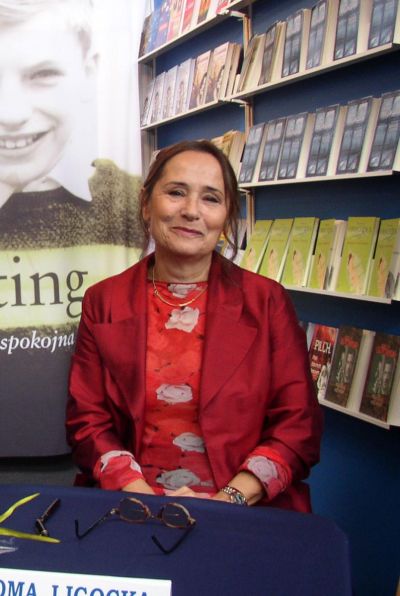Roma Ligocka: The girl in the red coat in “Schindler’s List”

Roma was born in Kraków on 13 November 1938 to her Jewish parents Teofila (née Abrahamer) and David Liebling. Not yet two years old, she was uprooted to the Kraków Ghetto where she was to spend the defining years of her earliest childhood. In her small red coat, Roma was the only spot of colour in the cold, grey ghetto, and was lovingly called “little strawberry” by her friends and family. The living conditions in the apartment that the family has to share with several other inhabitants were unbearable There was no space, no food and it stank. Whilst sure in the knowledge that there was a life outside the ghetto, the three-year-old did not understand why her life was now marked by hunger, poverty and fear, How could she. As a “hidden” child, the only things she knew were misery and the daily fear of the German soldiers in the ghetto:
“They shout, we obey. Anyone who does not obey is killed.”
The terror inflicted on the inhabitants of the ghetto escalated, more and more people were deported:
“We keep waiting - for nothing. We wait day and night. Nobody knows what tomorrow will bring. We are sorted out; we are continuously sorted out like merchandise. Street by street, house by house, we are ringed in more and more. (…) People go and simply do not come back again. You have only just got used to a face, and then it is gone again.”
First, Roma’s grandmother is deported to a concentration camp, then later her father as well. Finally, mother and daughter managed to flee from the ghetto. Harbouring forged documents, they hid with a Polish family from March 1943 until the end of the war, and this is how they managed to avoid being deported to the extermination camp:
“I spent my whole childhood with the Kierniks on my tiptoes, that’s how it seems to me today. There were dolls and theatre plays, books, music, pens and paper, and something like a home; even if none of it belonged to me. It was a borrowed life, a borrowed childhood with a borrowed family (…) After that, my childhood was over.”
At the end of the war, Roma was six years old. Over the coming weeks, the few survivors from their circle of friends and acquaintances gradually found their way back together in Kraków. Little Roma was faced with the psychological stress of her environment which, as a child, she did not really know how to classify or process:
“I have the grown-ups’ stories in my ear always and I can never forget them. Covering my ears, crawling under the bed or pulling the cover over my head - none of it helped. There was no escape, no mercy for us children. We were unwilling witnesses of those who bore witness.”
The survivors of the concentration camp seemed to her as if they had gone mad. She did not recognise her father who survived the Plaszów and Auschwitz concentration camps and returned to Kraków. Her closest confidante during this time is her mother. She made friends with Ryszard Horowitz, who was the same age, and her cousin Roman Polański, who was six years older, with whom she went on adventures through the city. Slowly Roma and the other survivors settled in to a life in the post-war period: Roma went to school and completed her school-leaving exam before studying painting and stage design at the renowned Akademia Sztuk Pięknych im. Jana Matejki in Kraków. But the trauma of her early years would stay with her for the rest of her life.
She fell in love with the director Jan Biczycki, who gained nationwide popularity as the artistic director at the Juliusz-Słowacki Theatre in Kraków . During their honeymoon in Austria in 1965, the young couple decided not to return to Poland. The couple moved around Western Europe for years staging theatre pieces – even after the birth of their son Jakob. Roma worked as a costume designer and stage designer in theatres, operas and in film and television. Her husband Jan found himself again in the international theatre scene. These years of travelling took them to Graz, Vienna, Cologne, Frankfurt am Main and Copenhagen. When their son was five years old, the family settled in Ottobrunn near Munich. But despite the success in her personal and professional life, Roma suffered severe psychological setbacks because she was unable to process her childhood trauma. It signalled the breakdown of her marriage, after which she left Ottobrunn and moved to Stuttgart with her son. Her life continued to be marked by severe depression and panic attacks.
After years of suppressing everything that happened, it is a film that finally gives Roma the impetus to consciously confront her past: 2 March 1994 is the première of Steven Spielberg’s “Schindler’s List” in Kraków, to which, along with personalities from politics and culture, holocaust survivors and their families are invited. After initially resisting attending the première, Roma found herself in the cinema with her son – and found herself confronted with her own story on the screen:
“In the Ghetto. Dark apartments. Confinement. Escape, Suitcase. Screams. Tears. Boots. (…) The Girl in the Red Coat.”
A turning point in the life of the 55-year-old who finally felt inspired and strong enough to tell the story of what she experienced.
Her novel, a bestseller, was published in 2000 under the title “The Girl in the Red Coat” and was translated into 25 languages. The autobiographical novel does not just create an image of a childhood during the Second World War. The author also tells the story of a young woman who, after her harrowing experiences in the war, searches in vain for a place in Polish society and later in German society - and in doing so creates a valuable historical eyewitness account. Today, Roma Ligocka lives in Munich and Kraków. Katarzyna Salski
Katarzyna Salski, may 2018
Roma Ligocka (with Iris von Finckenstein): “The Girl in the Red Coat”. Penguin Random House, 2003.
The scene with the girl in the red coat from "Schindler's List": https://www.youtube.com/watch?v=tvALjQ_QuI0


